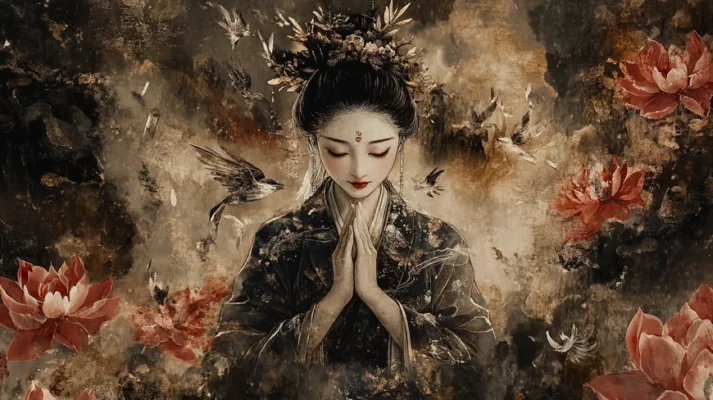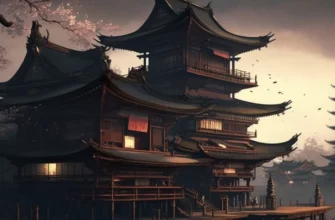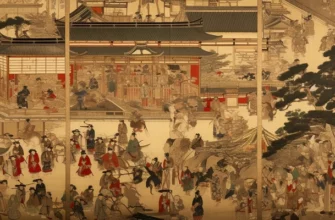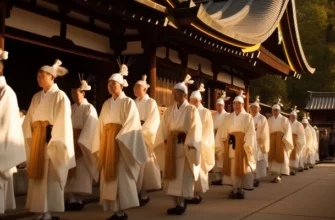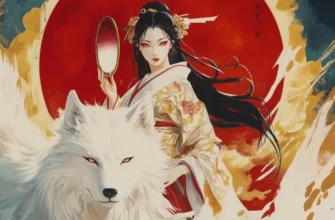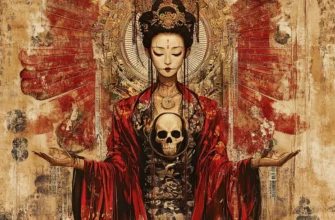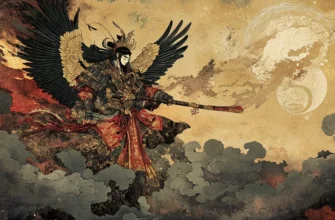Ame-no-Uzume is one of the most colorful figures in Japanese mythology, known as the goddess of joy, dance, and dawn. Her name is closely associated with the legend of the return of light to the world when the sun goddess Amaterasu hid in the Heavenly Cave, plunging the world into darkness.
According to the myth, Ame-no-Uzume used her dance to attract the attention of the gods and force Amaterasu to come out of the cave. Her cheerfulness and spontaneity created an atmosphere of joy and laughter, which eventually restored harmony to the world.
The image of Ame-no-Uzume is closely associated with symbols of joy and renewal. In traditional Japanese art, she is often depicted as a woman dancing with a mirror or other ritual objects.
In modern culture, she remains a symbol of harmony, creativity, and the ability to transform darkness into light through joy and inspiration. Her cult plays an important role in many religious rituals and celebrations in Japan, retaining its significance throughout the centuries.
The significance of Ame-no-Uzume in Japanese culture
Ame-no-Uzume is an important symbol in Japanese culture, representing joy, dance, and rebirth. She acts as a mediator between the world of gods and humans, using creativity, humor, and positive energy to achieve harmony.
Her significance is most evident in the myth of Amaterasu, where she uses dance and merriment to bring back the sun and, with it, light and order to the world. This story symbolizes the power of joy and collective action to overcome adversity.
In traditional Japanese culture, Ame-no-Uzume is revered as the patroness of theater, art, and ritual dance, particularly kagura, sacred performances performed in honor of the gods. Her image also reminds us of the importance of lightness, laughter, and creativity even in the darkest times.
Contemporary Japanese culture continues to draw on the symbolism of Ame-no-Uzume, depicting her as a source of inspiration for artists and people who seek harmony in life. Her story reminds us that light can always return if we do not lose hope and find joy in simple things.
Ame-no Uzume symbolizes joy, renewal, and the power of creative expression. As the goddess of joy, dance, and dawn, she embodies the ability to overcome darkness — both physical and metaphorical — through laughter, lightness, and art.
In Japanese mythology, Ame-no-Uzume’s dance symbolizes the energy that inspires action, awakens the spirit, and unites the community. Her famous dance at the Heavenly Cave shows how joy and celebration can be a means of solving serious problems and restoring harmony.
The dawn associated with Ame-no Uzume represents the beginning of a new cycle, hope, and renewal. It symbolizes the moment when the darkness of night gives way to the light of day, reminding us of the cyclical nature of life and the need to believe in new opportunities.
Overall, her symbolism emphasizes the importance of joy, art, and harmony as key elements of spiritual and social well-being. She inspires people to find light even in the darkest moments of life.
Origin and role in mythology
Amaterasu is one of the oldest goddesses in Japanese mythology, mentioned in the texts of Kojiki and Nihon Shoki. She belongs to the gods who appeared during the creation of the world. Her name means “Heavenly Joyous Priestess,” emphasizing her nature as a goddess of joy and festive rituals.
The most famous story about Ame-no-Uzume is connected with the legend of Amaterasu, the goddess of the Sun, who hid in the Heavenly Cave after a conflict with her brother Susanoo. Her hiding plunged the world into darkness, disrupting the order of the universe.
Ame-no-Uzume became the heroine of this crisis. She performed a passionate and playful dance, during which she partially exposed herself, causing laughter and curiosity among the other gods. This noise attracted the attention of Amaterasu, who peeked out of the cave, and the gods took advantage of the moment to return her to her heavenly throne. Thanks to this, light and harmony were restored.
Ame-no Uzume is also associated with rituals and celebrations that emphasize joy and unity among people. She is considered the first priestess to have initiated the tradition of sacred dances (kagura), which became part of Shinto rituals.
In Japanese mythology, Ame-no-Uzume symbolizes not only joy and art, but also the ability to resolve conflicts and overcome darkness through creativity and cooperation. Her image remains important in Japan’s religious and cultural traditions, inspiring harmony and renewal.
Place in the pantheon of gods
Ame-no Uzume occupies a special place in the Japanese pantheon of gods, being one of the most revered kami (divine beings) in Shintoism. She is one of the deities who act as intermediaries between the human world and the world of the gods. She is considered the patroness of joy, festive rituals, and dance.
Connection to major gods
Ame-no-Uzume is closely associated with key figures in Japanese mythology:
Amaterasu, the goddess of the sun — it was thanks to Ame-no-Uzume that Amaterasu was brought back from the Heavenly Cave, making her an important figure in the restoration of cosmic order.
Susanoo, the god of storms and chaos — the story of reconciliation and the return of harmony shows her role as a stabilizing force in the confrontation with chaotic energies.
Ame-no-Uzume is revered as the patroness of traditional Japanese arts, particularly ritual dances (kagura) performed in honor of the gods. Her role emphasizes the importance of joy and festive rituals in maintaining harmony between the human world and the world of the gods.
As a goddess who brings light, joy, and harmony, Ame-no-Uzume serves as an example of how creativity and humor can overcome the darkest moments. She is a kind of “bridge” between the spirit world and the human world, reminding us of the need for positivity and balance in the interaction between them.
Thanks to her significant role in famous myths and her influence on cultural traditions, Ame-no-Uzume remains one of the key figures in Japanese mythology and culture.
As one of the central goddesses of Japanese mythology, Ame-no-Uzume plays an important role in interactions with other deities, especially in the context of key myths and rituals.
Connection to Amaterasu
Ame-no-Uzume is best known for her role in the myth of the sun goddess Amaterasu. After Amaterasu hid in the Heavenly Cave due to a conflict with her brother Susanoo, the world was plunged into darkness. Through her dancing and merriment, Ame-no-Uzume was able to pique Amaterasu’s curiosity and lure her back to the world, restoring cosmic order. This made her a symbol of harmony and unity.
Interaction with Susanoo
Although Ame-no-Uzume did not directly oppose Susanoo, the god of storms and chaos is the opposite of her peaceful and life-affirming nature. Her ability to overcome the effects of the chaos created by Susanoo makes her an important stabilizing force in mythology.
Connection to Futodama
In the myth of Amaterasu, Ame-no-Uzume worked together with the god Futodama, who performed rituals to support her dance. Their partnership symbolizes the union of creative and sacred forces to restore harmony.
Ame-no Uzume is also considered a mediator between humans and gods, so her image is often associated with ritual ceremonies, celebrations, and art. She embodies the power of joy that unites all divine beings in a common goal of maintaining order in the universe.
Thanks to her role in mythology, Ame-no-Uzume symbolizes unity and the harmonious coexistence of opposing forces such as chaos and order, light and darkness, joy and sorrow. Her connection to the deities of the Japanese pantheon emphasizes the importance of cooperation and creativity in overcoming difficulties.
The myth of saving the world
One of the most famous myths in which Ame-no-Uzume plays a key role is related to the return of light to the world after the sun goddess Amaterasu hid in the Heavenly Cave (Ame-no-Iwata). This led to darkness and chaos, as Amaterasu was the source of light and life for the entire world.
In response to this catastrophe, the other gods gathered to find a way to lure Amaterasu out of the cave and restore order to the universe. Among them was Ame-no-Uzume, who, known for her ingenuity and cheerfulness, decided to use her dance as a means of attracting the attention of the sun goddess.
Ame-no-Uzume began to dance in front of the Heavenly Cave. She performed an entertaining and humorous dance, during which she partially exposed herself, causing laughter and admiration among the assembled gods. Her dance and cheerfulness amused the gods and caused a commotion that attracted Amaterasu’s attention.
This noise intrigued Amaterasu, and she decided to peek out of the cave to see what was happening. One of the gods, named Tajikarao, quickly closed the cave door at that moment, preventing Amaterasu from returning. Thus, light returned to the world, and order was restored.
The myth of the salvation of the world through Ame-no-Uzume’s dance symbolizes the importance of joy, creativity, and cooperation in overcoming darkness and difficulties. Her role emphasizes that even in the darkest moments, laughter and positive thinking can be powerful tools for change. This story also teaches that harmony and balance between opposing forces, such as light and darkness, can be restored through collective action and creativity.
In this way, Ame-no-Uzume not only saved the world, but also left a mark on Japanese culture as a symbol of hope, joy, and the power of art to change reality.
The story of the hiding of the sun goddess Amaterasu
One of the most famous myths in Japanese mythology tells how the sun goddess Amaterasu hid in the Heavenly Cave (Ame-no Iwaya), causing darkness and chaos in the world. This story emphasizes the importance of Amaterasu as a source of light, warmth, and life for all living things.
The myth begins with Amaterasu having a conflict with her brother, the god of storms and chaos, Susanoo. After a series of misdeeds committed by Susanoo in the heavenly realm, Amaterasu, having lost trust and feeling insulted, decided to hide in the Heavenly Cave. As a result, the world was plunged into absolute darkness, and order in the universe was disrupted. Without Amaterasu’s light, life became impossible, and the gods began to suffer from the cold and darkness.
The gods decided to do everything possible to bring Amaterasu back. They gathered together and came up with a plan to force her out of the cave. One of the gods, named Tajikarao, was chosen to physically hold the cave door when the goddess decided to come out. At the same time, the other gods began to make noise and have fun to attract her attention.
At this critical moment, Ame-no-Uzume, the goddess of joy, dance, and celebration, came to the rescue. She began to perform a bright, captivating dance full of humor and playful movements. Her dance and laughter attracted the attention of the other gods and caught Amaterasu’s attention. Among the gods watching was even Dizutai himself, the god who kept order.
When Amaterasu heard the laughter and noise, she decided to peek out of the cave to see what was happening. While she was looking, the gods quickly closed the door, preventing her from returning inside. Amaterasu was unable to return to her hiding place, and the world was once again filled with light.
Symbolism and meaning
This story about Amaterasu’s hiding and return symbolizes the victory of light over darkness, joy over sadness, and harmony over chaos. It shows that even in the most difficult moments, when everything seems lost, creativity, cooperation, and laughter can change the situation for the better.
The role of Ame-no-Uzume in this story is particularly important because she symbolizes the importance of joy, creativity, and collective action in overcoming difficulties. She reminds us that sometimes solutions come not through seriousness, but through lightness, creativity, and positivity.
Ame-no Uzume’s dance became a key moment in the myth of the return of light to the world. This scene not only emphasizes the importance of joy and creativity, but also demonstrates how laughter and merriment can change the situation for the better even in the darkest times.
Ame-no-Uzume, known for her cheerful nature and talent for dancing, decided to perform an entertaining, even humorous dance in front of the Heavenly Cave, where the sun goddess Amaterasu had hidden herself. Her dance was not only captivating but also daring — she partially exposed herself to attract attention and entertain the other gods.
Ame-no-Uzume’s dance delighted the other gods who watched her and laughed. Their laughter and joy became a powerful sign that life and order could be restored. Attracted by the noise and merriment, Amaterasu, curious about what was happening outside, decided to peek out of the cave.
At that moment, the god Tajikarao closed the cave door, preventing Amaterasu from returning inside. The return of light to the world became a symbol of the victory of harmony over chaos, joy over sadness, and life over darkness. Thanks to the dance of Ame-no-Uzume, which became the catalyst for this change, the world was once again filled with light, and order was restored.
The dance of Ame-no Uzume embodies the importance of creativity, a positive attitude, and unity in overcoming difficulties. It shows that even in the most difficult times, creativity and laughter can be powerful tools for restoring harmony and balance. Ame-no Uzume has become a symbol of joy, hope, and the ability to change reality through art and collective effort.
This story teaches us that even in the darkest moments, strength can be found in simple but powerful actions that bring light and inspiration back into our lives.
Attributes and symbols
Ame-no Uzume, the goddess of joy, dance, and celebration, has several important attributes and symbols that reflect her essence and role in Japanese mythology. Her main attribute is dance, as she is known for her ability to perform captivating and humorous dances that bring joy and harmony. Ame-no Uzume’s dance has become a symbol of creativity and the ability to change situations through art. The mirror is also an important symbol associated with her, as in one version of the myth she used a mirror to attract the attention of Amaterasu, who was hiding in a cave. The mirror symbolizes self-knowledge, light, and truth, and is also a sign of divine presence.
Ame-no Uzume symbolizes harmony and joy, which is manifested in her ability to entertain and uplift the gods and people. Her dances and behavior are a reminder of the importance of positive thinking and joy in life. In many depictions, she can be seen wearing bright and luxurious clothes decorated with colorful patterns symbolizing the colors of dawn and life energy. The instruments she uses during her ritual dances, such as bells and drums, enhance the festive atmosphere and help create a sense of unity and joy. Smiles and laughter are also important symbols that emphasize her ability to laugh and create an atmosphere of fun even in difficult situations.
Ame-no Uzume can also be associated with natural symbols, such as flowers blooming and images of nature, reflecting her connection with renewal and rebirth. Ame-no-Uzume’s attributes and symbols reflect her unique role as the goddess of joy, dance, and light, emphasizing the importance of harmony and unity in life.
Image and depiction of the goddess
The image of Ame-no-Uzume in Japanese mythology is full of vivid and symbolic elements that reflect her essence as the goddess of joy, dance, and celebration. She is depicted as a woman full of optimism and energy, who is not afraid to use humor and creativity to achieve her goals. Her face usually reflects joy and carefreeness, and her eyes sparkle, symbolizing her ability to ignite and maintain light even in darkness.
She is often depicted in bright, colorful clothing decorated with patterns reminiscent of the colors of dawn or natural landscapes. These outfits emphasize her connection to life energy, rebirth, and harmony. Ame-no-Uzume may be depicted with traditional Japanese accessories, such as a narrow belt (obi) or luxurious jewelry, which add to her majesty.
Other elements that often accompany her image include musical instruments that she uses during her dances, such as bells and drums. These instruments add dynamism and rhythm to her image, emphasizing the importance of music and dance in her life. She may also be depicted in the midst of her famous dance, her movements expressing the joy and merriment that fill the space around her.
Ame-no-Uzume is sometimes depicted surrounded by other gods who look at her with amazement and admiration. This scene reflects her ability to change the atmosphere and bring light even when chaos reigns around her. She is a symbol of joy, humor, and the power of art to awaken and change the hearts of people and gods.
How Ame-no-Uzume is depicted in art.
Ame-no Uzume is often depicted in Japanese art as a bright and dynamic figure, reflecting her role as the goddess of joy, dance, and celebration. Her image in art is distinguished by its grace and energy, which emphasize her unique nature.
One of the most common depictions of Ame-no-Uzume is a scene where she performs her famous dance in front of the Heavenly Cave to attract Amaterasu’s attention and bring light back to the world. In such paintings or sculptures, the goddess is often depicted in a graceful pose, in motion, with a joyful expression on her face. Her clothing may be depicted as colorful, often traditional Japanese kimonos, decorated with various patterns symbolizing the colors of dawn, nature, and life energy.
Art often emphasizes her cheerfulness through the bright colors used to depict her face, clothing, and surroundings. Ame-no-Uzume may be shown with musical instruments such as bells, drums, or gongari, which add rhythm to her image and emphasize the importance of dance and music in her role.
In some cases, images of Ame-no-Uzume can be found in drawings or engravings, where her dance conveys both humor and elegance. She may be depicted with a big smile, revealing her friendly and cheerful nature. Other gods watching her are often shown with expressions of surprise and admiration, emphasizing the importance of her actions in bringing light back to the world.
Sculptures of Ame-no-Uzume also often depict her as a dynamic figure in motion, with swirling clothes and her head raised, symbolizing her confidence and cheerfulness. In some cases, she may be depicted in the context of a festival or ritual, where the dance is accompanied by music and singing, creating an atmosphere of festive harmony.
In general, Ame-no-Uzume always appears bright, cheerful, and full of energy in art, reflecting her role as a goddess capable of changing the world around her through art and joy.
Cult and legacy
The cult of Ame-no-Uzume is significant not only in the context of religious practices but also in the cultural perception of Japan. She is a symbol of joy, creativity, and life energy, and this image has left a deep mark on Japanese art, theatrical traditions, and folklore.
The cult of Ame-no-Uzume was particularly important during a period when the Japanese sought to preserve harmony and joy in their lives. Its history, linked to the myth of the return of light, taught that even in times of great hardship and darkness, it is possible to find a way to restore harmony through a positive attitude and creative expression. This became the basis for rituals and festivals where dances, songs, and musical performances symbolizing the energy and light brought by the goddess were performed.
In cultural heritage, Ame-no-Uzume is often mentioned in traditional Japanese theater arts, particularly in Noh and Kabuki theater. In these performances, she may appear as a character symbolizing festivity and humor, often accompanied by dances and music reminiscent of the myth of Amaterasu’s return. These performances, in turn, maintain a connection between the audience and ancient myths, helping to pass on cultural values to future generations.
Ame-no-Uzume has also left her mark on Japanese painting and sculpture. Depictions of the goddess in art often convey her dynamism, joy, and creativity. She is often depicted in bright colors, with a smile and free movements, emphasizing her connection with nature, rebirth, and light.
In modern Japan, the cult of Ame-no-Uzume has been preserved in the form of festivals and celebrations that honor her role as a source of joy and inspiration. These include dances, music, and other elements that recall her history and significance in Japanese culture. This unique celebration is a reminder of the importance of a positive outlook on life and the ability to find light even in darkness.
The legacy of Ame-no Uzume lives on in contemporary social and cultural practices, where her image inspires people to find joy in everyday moments and use art as a means of self-expression and strengthening bonds within society.
Rituals and ceremonies
Rituals and ceremonies associated with Ame-no-Uzume often aim to restore harmony, celebrate joy, and express gratitude for light and positive change. As the goddess was a symbol of dance, music, and joy, rituals associated with her usually include elements that encourage laughter, merriment, and harmony.
One of the main rituals is the performance of dances and musical performances during festive events. These performances may include traditional Japanese dances accompanied by drums, bells, and other instruments that create rhythm and a festive atmosphere. Dancing is not only entertainment, but also a way of expressing gratitude and attracting positive energy, symbolizing the goddess herself. They are often performed during New Year celebrations, spring festivals, and other important events when people seek to restore harmony and receive blessings.
Another important aspect is rituals accompanied by singing and music, which are interpreted as symbols of joy and life energy. In this context, rituals may include group singing, performing songs about the exploits of Ame-no-Uzume, her dances, and her role in the myth of the return of light.
Another common ritual is “calling the light,” or a ritual symbolizing the restoration of light and grace. This may take the form of lighting candles, fireworks, or other lighting elements reminiscent of Amaterasu’s return from the cave and the restoration of light to the world. Such a ritual may be accompanied by the sound of bells or sound effects that add to the festive atmosphere.
The actual celebrations associated with Ame-no-Uzume are often held in shrines dedicated to her. In such places, you can find rituals where people pray, bring gifts, and praise the goddess for her ability to bring joy and light. Often, dance workshops are held at these shrines, where anyone can learn the basic elements of Japanese dance and thus participate in a traditional practice that reflects the spirit of the goddess.
Thus, the rituals and ceremonies associated with Ame-no-Uzume not only reflect her essence but also uphold traditions that promote collective joy, interconnectedness, and a festive mood among people.
Influence on contemporary culture
The influence of Ame-no-Uzume on contemporary Japanese and global culture can be seen in various forms, from art to modern rituals, literature, and popular culture. Her image as a goddess of joy, dance, and light continues to inspire people and serves as a symbol of creativity, optimism, and a positive outlook on life.
In modern Japanese society, Ame-no-Uzume remains a popular symbol. Her myth is often used in literature, theater, film, and television programs, where she is often portrayed as the embodiment of fun, ingenuity, and the ability to change situations for the better. Stories about her can serve as allegories for overcoming difficulties and finding ways out of crisis situations.
In the arts and culture, Ame-no Uzume inspires artists, designers, and musicians. She often appears in contemporary paintings, sculptures, and illustrations, where she is depicted in colorful costumes and movements that symbolize energy and dynamism. Her image is actively used in anime, manga, and video games, where she often appears as a character who brings joy and lifts spirits.
In Japanese popular culture, Ame-no-Uzume is part of festive events and festivals celebrated to raise public spirits and create an atmosphere of joy. These celebrations often feature performances by dancers, musicians, and theatrical productions inspired by her myth. They help strengthen community ties and remind people of the importance of positive thinking.
Ame-no Uzume has also found a place in world culture through numerous interpretations of her myth and symbolism. Her image is often the subject of research and analysis among cultural scholars and artists interested in the influence of Japanese mythology on other cultures and contemporary trends. Her unique ability to use humor and creativity as tools for change inspires people to seek unconventional solutions in their own lives and creative endeavors.
Contemporary rituals associated with Ame-no-Uzume may include dances, musical performances, and other forms of expression that remind us of her importance in the cultural context. These practices promote the development of creative skills and enhance interpersonal connections, reminding us of the importance of joy, community, and harmony in society.
Conclusion
The Japanese goddess Ame-no-Uzume occupies an important place in Japanese mythology and culture, representing a symbol of joy, creativity, and the ability to restore harmony in the world. Her role in the myth of Amaterasu’s return demonstrates the power of a positive attitude, humor, and art as tools for overcoming crises and restoring light and harmony. Through her famous dance, Ame-no-Uzume showed that even in the darkest times, it is possible to find a path to change and renewal.
The cult and legacy of Ame-no Uzume are reflected in numerous rituals, celebrations, art, and contemporary culture. She continues to inspire artists, musicians, and anyone seeking joy and inspiration in their creative endeavors. Her image is a symbol of the power of a positive approach to life and the ability to find light in the most difficult situations. In modern Japan and beyond, Ame-no-Uzume reminds us of the importance of creative expression, humor, and unity in society, making her a relevant and significant figure even today.
Ame-no-Uzume is important to the modern world as a symbol of the power of joy, creativity, and life energy. In times when people often face difficulties, stress, and uncertainty, her image reminds us of the importance of a positive approach to life, art, and the ability to find light even in darkness. Her myth of the dance that brought light back to the world is a metaphor for all who seek ways to overcome obstacles and restore harmony in their lives.
The modern world, with its fast pace and technological changes, often requires us to be creative and think outside the box. As a symbol of creative expression and joy, Ame-no Uzume reminds people of the importance of flexibility, humor, and collective support. Her influence can be seen in contemporary art, where images and ideas inspired by her image reflect the importance of emotional health and inspiration.
In addition, the image of Ame-no-Uzume inspires positive change in society by encouraging cooperation, mutual support, and celebration of life. Her lessons and example demonstrate that, despite difficulties, there is always room for joy, laughter, and hope to help us move forward.
In a globalized world where cultures and ideas quickly cross borders, the image of Ame-no-Uzume serves as a universal symbol of hope and optimism. She reminds us that even in the most difficult times, we can find the strength to change, and that true strength often lies in the ability to keep lightness and joy in our hearts.
